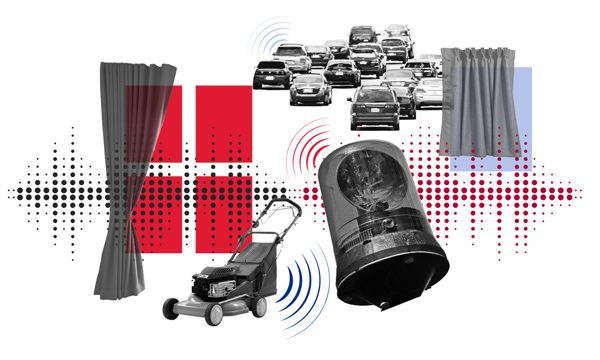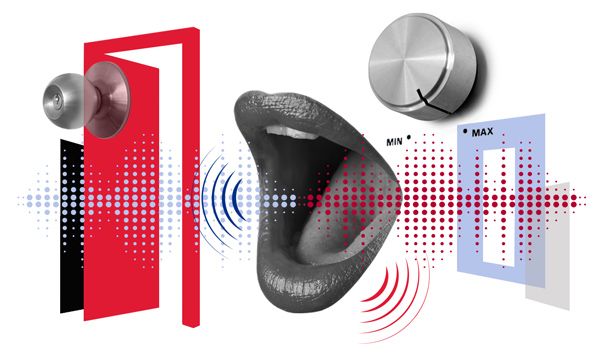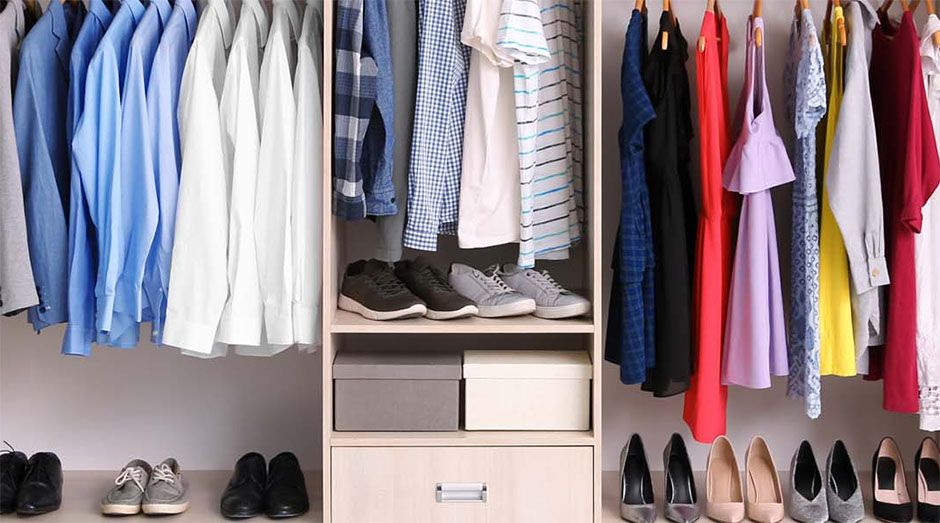"...increase the mass and mitigate the sound."
— Lee Bartolomei, Los Angeles acoustic consultant
Ingrid Gordon plays percussion instruments for a living and practices at home, in a co-op in Queens, New York. She and her husband, Alex Gelfand, had no clue her drums and marimba were rattling their neighbors’ nerves until they asked the co-op board for permission to buy a bigger unit one floor up.
That’s when one of the neighbors brought it up in a board meeting. “They said if they had known how noisy we’d be, they never would have voted us in in the first place,” recalls Gelfand.
Wanting to be better neighbors — and to upgrade their unit at the same time — they promised to do everything they could to squelch their noise if they got the green light to purchase the two-bedroom. “It was a totally reasonable request,” says Gelfand. “What we didn’t know was how much work it was going to be.”
Many homes weren’t built to handle the din of modern life. Cars and planes are the worst offenders when it comes to noise pollution. But often the most annoying sounds are close by, whether it’s cars blasting music or the neighbors blowing leaves at 7 a.m. on a Sunday.
“A lot of people think they can throw curtains and a carpet in a room to fix any noise problem,” says Los Angeles acoustic consultant Lee Bartolomei, who has helped quell noisy environments ranging from rowdy middle schools to upscale kitchens. “It’s basically engineering — and more complicated than tossing extra cushions on your couch.”

Buying or Renovating?
Talk to a Farmers agent about homeowners insurance.
Different sounds require different soundproofing strategies.
High-frequency sounds like a baby’s cry or a whistle are easier to keep out than low-frequency sounds that can make a house shake, says Brian Warwick, an Emmy Award–winning recording engineer, teacher and builder of sound studios in Vermont and New Hampshire. “Like when a teenager drives by with a subwoofer in the car or a helicopter is hovering above — these are low frequency and they travel easier through walls, whereas high frequencies get blocked.”
To dampen a noise, the idea is to block the pathways that moving air molecules — sound waves — squeeze through. “It’s about eliminating any direct paths — and these can be tiny — that let air come through,” says Bartolomei.
It’s also about creating layers of sound barriers. Heavy curtains and extra couch cushions can help, but only as add-ons, after sealing even the smallest avenues for noise transmission. These strategies — some DIY, some requiring professional help at considerable cost — come first, according to Bartolomei.

Windows — The Easiest Fix
Windows — including sliding glass doors — are the thinnest barrier in any wall. Glass easily transmits sound waves, and frames around doors and windows tend to have many small cracks or joins that let sound sneak through, says Bartolomei, who suggests a few fixes for homeowners.
#1 LINE OF DEFENSE
Seal all seams and joints around windows with acoustic caulking. Unlike regular caulk, acoustic caulk is flexible and doesn’t crack or shrink over time. (Bonus side effect: it also keeps out drafts.)
#2 LINE OF DEFENSE
Add weather stripping. “This works like a threshold seal and is great for windows and sliding doors,” says Bartolomei. Once, in a hotel in Las Vegas, he was kept up by pounding music from the bar one floor down. “I couldn’t sleep at all. So the next day I bought a couple of rolls of weather-stripping tape,” he recalls. He unscrewed the sliding doors, put the weather stripping on the connecting surfaces, and put the doors back in. The difference in midnight noise was huge.
“Doing this should help significantly with any type of sound leaking through,” says Bartolomei — though he emphasizes that this is strictly a home remedy and does not recommend dismantling hotel doors.
#3 LINE OF DEFENSE
Replace all windows and sliding glass doors with double-pane versions. The double layers, and the space between them, help block sound waves — and provide insulation, too. They’re especially effective for noise from freeways or nearby schools and other mid-frequency sounds. This can get expensive. Double-pane windows vary in price but can start around $400 for a small window and rise to $1,000 or more, including installation. Triple-pane windows will deaden more sound but cost even more.
#4 LINE OF DEFENSE
Remove in-window AC units, which are avenues for sound travel, and install forced-air systems instead. Costs can vary, says Daniel Dimidjan, who installs forced-air and split systems in California and Utah. He notes that adding forced air to existing homes can cost $2,000 to $10,000, depending on a number of factors including how a house is built, its electrical system, and whether there are existing ducts.
How Noisy is Your Neighborhood?

Walls and Ceilings — It’s All About Layers
“The only thing that stops sound from moving through objects is mass — increase the mass and mitigate the sound,” says Gelfand, who reinforced the walls and ceilings of their dining room to create their soundproof studio. Mass means the weight and density of everything from walls, ceilings and floors to doors.
Gelfand hired a sound specialist to design a complete scope-of-work for his soundproofing job. (Homeowners may want to consider this for a tricky or larger project.) “Our project cost about $7,000, but it could have been done a little bit cheaper if we’d done more of the work ourselves,” adds Gelfand, who worked with a sound consultant and contractor.
#1 LINE OF DEFENSE
Bartolomei recommends adding a layer of drywall over existing walls and ceilings. This is the easiest way to increase their mass and dull sound transmission.
Regular drywall — the mineral gypsum sandwiched between layers of paper — costs about $10 to $20 per 4-by-8-foot sheet, so a 12-by-16-foot room with 8-foot ceilings could be covered for roughly $200 to $400. But Bartolomei prefers using special acoustic drywall, which adds a layer of sound-deadening viscoelastic polymer. It costs at least five times more, starting at $50 a sheet, which could cost $1,000 for the same 12-by-16-foot room.
“But it’s literally 10 times as good as regular drywall for keeping sound out,” he adds.
Using viscoelastic glue, instead of regular glue, to cement the new drywall to the existing surface is another option that can add a flexible layer that helps keep sound wave vibrations from moving through.
#2 LINE OF DEFENSE
Warwick, the recording engineer, likes the vintage look of the exposed beams in his living room — but not hearing people walking around upstairs. “I’m going to add some dampening material [like insulation] to the ceiling, and then I’ll put some drywall on top of that, and it will look bright and white but the beams will still be visible,” he says.
#3 LINE OF DEFENSE
Ron Wittleton, who works for an insulation business in Northridge, California, recommends installing a layer of batt, roll or blown-in insulation in the attic to help block sounds coming in through the roof. “For sound, there are some great high-density materials,” he says. According to Wittleton, the most popular insulators are blow-in or fiberglass sheets, which start at about $950 and $1,100, respectively, for 1,000 square feet. Recycled denim insulation is popular but costs about three times more, says Wittleton.
How loud is too loud, legally?

Floors — Add a Little Extra Cushion and Space
Gelfand got a better idea of how much sound traveled between floors when his downstairs neighbors had a newborn — and he realized his own toddler stampede must have bothered them, on top of his wife’s percussion practice.
Area rugs or wall-to-wall carpet can help, but adding other layers will do more to cut noise transmission through floors. “Your floor can function like a drumhead if you don’t dampen it,” warns Gelfand. “Noise can travel up the walls from the floor. It’s called flanking noise.”
#1 LINE OF DEFENSE
Gelfand suggests adding mass-loaded vinyl. Sold in sheets, this vinyl is often made from recycled tire rubber and other eco-friendly materials. A layer of it under the carpet — or installed between the subfloor and a new wood floor — dampens impact noise like upstairs foot traffic, as well as sounds moving through air, like talking or a baby’s crying. Gelfand and his contractor installed a layer of this heavy, sound-deadening material under the carpet pad throughout his apartment. It cost about the same as a non-acoustic carpet pad, he says.
“Make sure to properly tape the seams to avoid sound seeping through the cracks in the seams,” suggests Gelfand.
#2 LINE OF DEFENSE
Bartolomei recommends installing resilient channel, a thin metal strip that is designed to substantially improve the sound insulation of drywall and plasterboard walls and ceilings.
“We wanted to turn the basement of our condo into a short-term rental,” say Jee-Young Kim, an executive assistant who lives with her husband, David, in Seattle. But they wanted to be sure the sounds of their daily living didn’t reverberate below.
So they used U-shaped strips of resilient channel to create a space between the ceiling of the new unit and the joists supporting the floor above. The space — or channel — effectively isolates drywall from the framing studwork, which substantially weakens sound waves.
“Our guests swear they never hear us upstairs, so it works great," says Kim.
#3 LINE OF DEFENSE
Bartolomei notes that furnishings like thick rugs, heavy curtains or an overstuffed couch may not offer significant soundproofing on their own, but coupled with other noise-muffling fixes, they offer a relatively easy, inexpensive solution for reducing sound.
White Noise—A Quick Fix?

Doors — Solid, Heavy and Tight-Fitting
When Gelfand set about creating both a practice space for his wife and a space where he could conduct work interviews uninterrupted, he discovered that the interior doors were weak spots. They were old and no longer fit their frames tightly, leaving sound-penetrating gaps.
#1 LINE OF DEFENSE
Thick, heavy doors that are fitted to their frames will block more sound than thin, ill-fitting ones. In this arena, sometimes older is better. Vintage solid hardwood doors — such as oak or walnut — are great for blocking sound because they are so dense, says Bartolomei. On the other hand, older doors may not sit flush against the frame or the floor, so they may need weather stripping or a rubber door sweep at the bottom to seal the gap against sound. One downside is that the seals may be visible.
“We ended up installing solid-core doors, which are extremely heavy — so again, mass is good,” Gelfand says. Neoprene seals around all the doors and a neoprene sweep originally designed for fireproofing added more sound protection.
Solid-core doors of varying weights are readily available. Installing them, however, may require a pro. Gelfand’s circa 1919 building has many small, crooked quirks. To install a new front door, he ended up asking his acoustic consultant, a licensed contractor and the door manufacturer for tips on getting a heavy door into an old, wonky frame.
There’s no single fix-it for quelling sound. The trick is doing more, and then more. “Soundproofing is an accretion of many things,” says Gelfand. “Each step or strategy will mitigate a little bit more noise, and by the time you’ve implemented three, four or five different ideas, it will be quieter.”

Noises That Drive Us Nuts (and Some That Don’t)
Measuring responses in the amygdala (the part of the brain that regulates emotion), researchers ranked the sounds that rankled participants in a study published in the Journal of Neuroscience.
Most Unpleasant Sounds
1. Knife on a bottle
2. Fork on a glass
3. Chalk on a blackboard
4. Nails on a blackboard
5. Female scream
6. Disc grinder
7. Squealing brakes
8. Baby crying
9. Electric drill
Least Unpleasant Sounds
1. Applause
2. Baby laughing
3. Thunder
4. Water flowing
Most Unpleasant Sounds
1. Knife on a bottle
2. Fork on a glass
3. Chalk on a blackboard
4. Nails on a blackboard
5. Female scream
6. Disc grinder
7. Squealing brakes
8. Baby crying
9. Electric drill
Least Unpleasant Sounds
1. Applause
2. Baby laughing
3. Thunder
4. Water flowing
Written by
The information contained in this page is provided for general informational purposes only. The information is provided by Farmers® and while we endeavor to keep the information up to date and correct, we make no representations or warranties of any kind, express or implied, about the completeness, accuracy, reliability, suitability or availability with respect to this article or the information, products, services or related graphics, if any, contained in this article for any purpose. The information is not meant as professional or expert advice, and any reliance you place on such information is therefore strictly at your own risk.
Related articles



